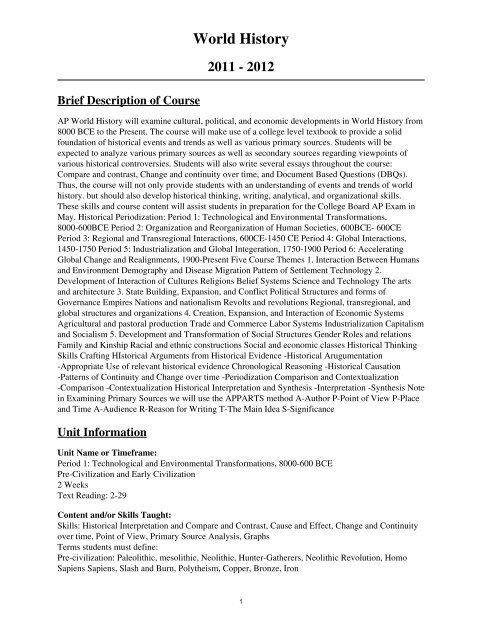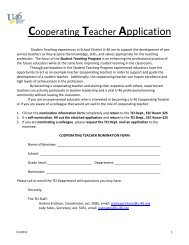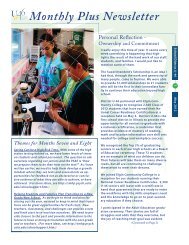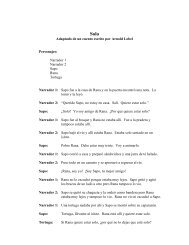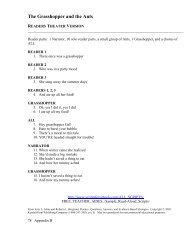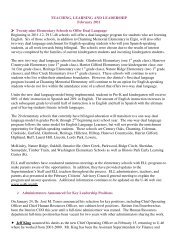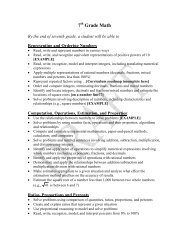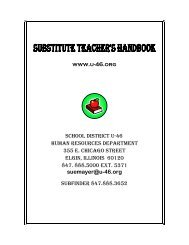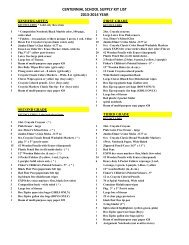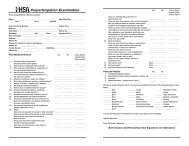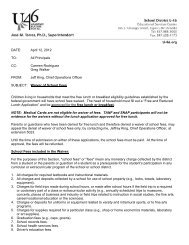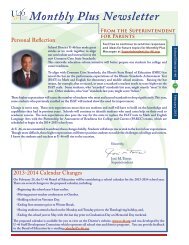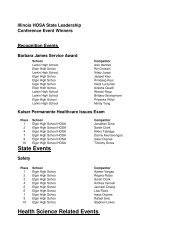AP World History
AP World History
AP World History
Create successful ePaper yourself
Turn your PDF publications into a flip-book with our unique Google optimized e-Paper software.
Brief Description of Course<br />
<strong>World</strong> <strong>History</strong><br />
2011 - 2012<br />
<strong>AP</strong> <strong>World</strong> <strong>History</strong> will examine cultural, political, and economic developments in <strong>World</strong> <strong>History</strong> from<br />
8000 BCE to the Present. The course will make use of a college level textbook to provide a solid<br />
foundation of historical events and trends as well as various primary sources. Students will be<br />
expected to analyze various primary sources as well as secondary sources regarding viewpoints of<br />
various historical controversies. Students will also write several essays throughout the course:<br />
Compare and contrast, Change and continuity over time, and Document Based Questions (DBQs).<br />
Thus, the course will not only provide students with an understanding of events and trends of world<br />
history. but should also develop historical thinking, writing, analytical, and organizational skills.<br />
These skills and course content will assist students in preparation for the College Board <strong>AP</strong> Exam in<br />
May. Historical Periodization: Period 1: Technological and Environmental Transformations,<br />
8000-600BCE Period 2: Organization and Reorganization of Human Societies, 600BCE- 600CE<br />
Period 3: Regional and Transregional Interactions, 600CE-1450 CE Period 4: Global Interactions,<br />
1450-1750 Period 5: Industrialization and Global Integeration, 1750-1900 Period 6: Accelerating<br />
Global Change and Realignments, 1900-Present Five Course Themes 1. Interaction Between Humans<br />
and Environment Demography and Disease Migration Pattern of Settlement Technology 2.<br />
Development of Interaction of Cultures Religions Belief Systems Science and Technology The arts<br />
and architecture 3. State Building, Expansion, and Conflict Political Structures and forms of<br />
Governance Empires Nations and nationalism Revolts and revolutions Regional, transregional, and<br />
global structures and organizations 4. Creation, Expansion, and Interaction of Economic Systems<br />
Agricultural and pastoral production Trade and Commerce Labor Systems Industrialization Capitalism<br />
and Socialism 5. Development and Transformation of Social Structures Gender Roles and relations<br />
Family and Kinship Racial and ethnic constructions Social and economic classes Historical Thinking<br />
Skills Crafting HIstorical Arguments from Historical Evidence -Historical Arugumentation<br />
-Appropriate Use of relevant historical evidence Chronological Reasoning -Historical Causation<br />
-Patterns of Continuity and Change over time -Periodization Comparison and Contextualization<br />
-Comparison -Contextualization Historical Interpretation and Synthesis -Interpretation -Synthesis Note<br />
in Examining Primary Sources we will use the <strong>AP</strong>PARTS method A-Author P-Point of View P-Place<br />
and Time A-Audience R-Reason for Writing T-The Main Idea S-Significance<br />
Unit Information<br />
Unit Name or Timeframe:<br />
Period 1: Technological and Environmental Transformations, 8000-600 BCE<br />
Pre-Civilization and Early Civilization<br />
2 Weeks<br />
Text Reading: 2-29<br />
Content and/or Skills Taught:<br />
Skills: Historical Interpretation and Compare and Contrast, Cause and Effect, Change and Continuity<br />
over time, Point of View, Primary Source Analysis, Graphs<br />
Terms students must define:<br />
Pre-civilization: Paleolithic, mesolithic, Neolithic, Hunter-Gatherers, Neolithic Revolution, Homo<br />
Sapiens Sapiens, Slash and Burn, Polytheism, Copper, Bronze, Iron<br />
1
Early Civilization: Civilization, Monotheism, 4 River Civlization, Meso-Aemrican Early Civ (Chavin<br />
and Olmec), Sumer, Babylon, Hammurabi, Akkad, Ziggurat, Pyramid, Nile, Tigris-Euphrates,<br />
Akhenaton, Pharaoh. Hwang-He, Oracle Bones, Pan-Ku, Indus, Harappa and Mohenjo Daro, Stupa,<br />
Judaism<br />
Lecture-Discussion: Causes and Effects of Neolithic Revolution<br />
Why some in New Guinea and Australia still Hunter-<br />
Gatherers<br />
Compare and Contrast cultural, political and<br />
Economic features of Egypt and Mesopotamia<br />
Overall features of 5 Early Civs (incl MesoAmer)<br />
Judaism chronology<br />
Maps:<br />
Spread of Agriculture from Mideast and other nodes<br />
Spread of humans from Africa to Pacific to Western Hemisph<br />
Location of 5 Early Civs and relation to equator<br />
Change of empires in Mideast<br />
Pictures:<br />
Students to note salient features<br />
-What characteristic of civilization/pre-civ does the<br />
object represent: Various Tools of Hunter-Gatherers<br />
Egyptian Art and Architecture<br />
Mesopotamian Architecture<br />
Mohenjo Daro<br />
China’s Bronze Art<br />
Graphs:<br />
Population Growth of <strong>World</strong> from 8000 BCE to Present<br />
Primary Source/Paragraph Response:<br />
Pictures of Tools--Purposes of Tools?<br />
Hammurabi’s Code--<strong>AP</strong>PARTS, How does the Code reveal information about gender and class status,<br />
and religion in Babylon?<br />
Secondary Source Paragraph Response:<br />
A Tale of Two Rivers, Nile and Mesopotamia by K. Reilly: Summary of article. Similarities and<br />
Differences between 2 rivers, How would the use of Hammurabi code help or hurt Reilly’s thesis?<br />
Periodization Paragraph Response:<br />
Compare and Contrast overall periodization of Stearns and David Christian<br />
Why are the 5 Early Civilizations different from Pre-<strong>History</strong>?<br />
Major Assignments and/or Assessments:<br />
Essays:<br />
Compare and Contrast social and economic aspects of pre and early civilization<br />
Analyze Change and Continuity over Time regarding government,<br />
society, and economy in Egypt and Mesopotamia, 3100-600 BCE<br />
Group Work:<br />
Analyze and compare various perpectives by historian as to why humans went from hunter gatherers<br />
to farmers: Stearns, Armesto, Christian, Diamond<br />
Exam:<br />
2 Day Test<br />
Day 1: 40 Multiple Choice Questions<br />
Day 2: 1 Essay-Compare and contrast cultural, political, and economic<br />
aspects of Mesopotamian and Egyptian civilizations, 3100-500 BCE<br />
2
Unit Name or Timeframe:<br />
Organization and Reorganization of Human Societies, 600 BCE-600CE<br />
Classical Age<br />
6 Weeks<br />
Text Readings, 35-106<br />
Content and/or Skills Taught:<br />
Skills: Primary Source analysis, Change and Continuity over Time, Compare and Contrast, DBQ<br />
Writing, Graphs<br />
Terms students must define:<br />
China: Zhou, Qin, Han, Daosim, Confucianism, Legalism, Feudalism, bureaucracy, Shi Huangdi, Wu<br />
Ti, Hsiung Nu, Silk Road, Calligraphy, Ancestor Worship<br />
India: Hinduism, Hindu Epics, reincarnation, Buddhism, Siddhartha, Jain, Mauryan, Ashoka, Kush,<br />
Gupta, Golden Age of Gupta<br />
Persia/Greece/Mediterranean: Rise of Persia, Achaemenids, Cyrus, Darius, Xerxes, Zoroastrianism,<br />
Persian Wars with Greece, Socrates, Plato, Aristotle, Golden Age of Athens, Antigone, Sophocles,<br />
Peloponnesian Wars, Phoenecians, Minoan, Mycenaen, Alexander, Hellenism, Gandharan Art<br />
Rome: Punic Wars, Roman Republic, Caesar, Augustus, Pax Romana Constantine, Roman<br />
Architecture<br />
Lecture-Discussion:<br />
3 Main Philosophies of Classical China<br />
3 Main Religions of India<br />
Greek Philosophy<br />
Causes of Fall of India, Rome, and China<br />
Maps-Identify salient features (geog/political/trade):<br />
Expansionism of China<br />
Spread of influence of HInduism (SE Asia) and Buddhism<br />
Expansion of India<br />
Mediterranean <strong>World</strong><br />
Silk Road<br />
Greece Vs Persia<br />
Hellenistic <strong>World</strong><br />
Expansion of Roman Empire<br />
<strong>World</strong> Migrations of 500 BCE, See Stearns Transparency which will include Bantu migrations, Early<br />
Pacific Ocean Migrations along with Huns, etc.<br />
Pictures:<br />
Daoist Vs. Confucian Art<br />
Hinduism or Buddhism?<br />
The Greek Ideal in Architecture and sculpture<br />
Greek influences on Roman art and archtiecture<br />
Graphs:<br />
Rise in Population in China since 200 BCE<br />
Chart of <strong>World</strong> Religions Today<br />
Primary Source paragraph response:<br />
Differences between Qin and Han (Quotations fm<br />
Shi Huangdi, Li Si, Wang Mang, Wu Ti)<br />
Philosophies of Han Fei Zi, Lao Tzu, Confucius-Who said it?<br />
C/C Philosophical statements of HInduism and Buddhism<br />
C/C Chinese and Indian Philosophies<br />
Allegory of Cave-Summary, Is it religious?<br />
Antigone excerpt-What is Antigone’s dilemma?<br />
3
Readings from Christianity-C/C to Plato, Conf, Buddha, Hammurabi<br />
Examine documents that consider Roman and Han attitudes of technology<br />
Secondary Source paragraph response:<br />
Qin and Han Bureaucracy by Patricia Ebrey<br />
Summarize article, explain her thesis, how would documents by the Qin and Han empires help support<br />
Ebrey’s thesis?<br />
Comparison of India and Greece by McNeill- Summary and give 2 similarities and differences<br />
The Greeks and Slavery, Anthony Andrews-Summary, To what extent was Greek society based on<br />
slavery?<br />
Nomads and Cross civilization exchange (spread of Buddhism and Christianity), Bentley-Compare<br />
and contrast spread of Buddhism and Chris.<br />
Periodization paragraph response:<br />
Compare and contrast differences between Hwang-He and Classical Civilization China.<br />
What makes classical civilization "classical?"<br />
Major Assignments and/or Assessments:<br />
Essays:<br />
Analyze the cultural, economic, and political changes and continuities in Classical China, 500<br />
BCE-200 CE.<br />
Compare and contrast philosophies, economies, and governments of classical India and China, 500<br />
BCE-500 CE<br />
Compare and contrast Greek and Roman civilizations<br />
DBQ: Analyze Roman and Han attitudes toward technology<br />
Group: Ann Landers: Philosopher. Students respond to various problems like an advice columist.<br />
However students must respond from the point of view of a classical philosopher: Confucius, Buddha,<br />
Socrates, Aristotle, etc.<br />
Exam:<br />
2 Day Test<br />
Day 1: 70 Multiple Choice Question<br />
Day 2: Essay 1-Analyze the religious, political, and economic<br />
changes and continuities over time in classical India, 1000BCE<br />
to 500 CE.<br />
Essay 2-Compare and contrast the mehtods of political control<br />
between the Han dynasty and imperial Rome.<br />
Unit Name or Timeframe:<br />
Period 3: Regional and Transregional Interactions, 600CE-1450 CE<br />
Post-Classical Era<br />
7 Weeks<br />
Text Readings: 117-352<br />
Content and/or Skills Taught:<br />
Skills: Compare and Contrast, DBQ WRiting, Change and Continuity over Time, Point of View<br />
Terms students must define:<br />
Rise of Islam: Bedouins, Muhammad, Quraysh, Umayyad, Banu-Hashim, Mecca, Medina, Hjira, 5<br />
Pillars, Quran, Qanats, spread of Islam, Shia-Sunni split, 3 Holy cities of Islam, Muawiya, Mawalis,<br />
Dhimmis, Caliphate, Abassid, Islamic Golden Age, Harun Al Rashid, Primacy of Baghdad<br />
Islamic <strong>World</strong>: Cordoba Caliphate, ulama, sufis, Rubiyat, Saladin, Seljuk Turks, Buyids, Madluks, Al<br />
Razi, Averroes, Harsha, Gazni, Ghur, Delhi Sultaniate, Shrivijaya<br />
Africa in post-classical world: Bantu Migrations, stateless societies, animism, Sahel Kingdoms,<br />
Ghana, Mali, Songhai, Almoravids, Sundiata, griot, Mansa Musa, Gold for salt trade, Timbuktu,<br />
4
Matriarchy, Kongo confederacy, Great Zimbabwe, Axum, Swahili Coast<br />
Eastern post-classical Europe: Byzantine Empire, Justinian, Hagia Sophia, Theodora, E. Orthodox,<br />
iconoclasm, Schism 1054, Bulgaria, Tsar, slavs, Manzikert, Sack of Constantinople, Russia, Muscovy,<br />
Rurik, Kiev,Cyril and Methodius, Vladamir I<br />
Post-Classical Europe: Feudalism, Manorialism, Rise of Christianity, Clovis, Charlemagne,<br />
monasteries, Treaty of Verdun, Vikings, Magyars, Moors, Crusades, New Ag Tech, Commercial<br />
Revolution, investiture, Hanseatic League, Scholasticism, Magna Carta, 100 yrs war, Black Plague,<br />
Vernacular<br />
Meso and South America on the eve of European Encounter: Olmecs, Teotihuacan, Toltecs, Aztecs,<br />
Nahuatl,Quetzalcoatl, chinampas, Mayas, calpulli, Chavin, Nazca, Tiwanaku, Incas, Ayulli, terraces,<br />
tambos, quipus<br />
Post-Classical China: Sui, Tang, Song, Grand Canal, Jurchens, Liao, Tang Taizong, N and S Song,<br />
Kaifeng and Hangzhou, Buddhism in China, Tang-Song Golden Age, Li Bo and Tu Fu, Wang An Shi,<br />
Scholar Gentry, Neo Confucianism<br />
Post-Classical East Asia: 3 Kingdoms of Korea, 3 Dynasties (Silla, Koryo, Choson), Mongol rule,<br />
Achievements of Choson Dynastiy, Han-Gul, Buddhism and Conf in Korea, Nara, Kyoto, Fujiwara,<br />
Gempei Wars, Samurai, Daimyo, Shogun, Hiragana, Bushido, Kanji, Zen<br />
Post-Classical SE Asia: Truong Sisters, Le Dynasty, Nguyen Dynasty, Burma, Pagan, Anarwatha,<br />
Cambodia, Ankor Wat, Thailand, Sukhotai, Hinduism and Buddhism in Indochina<br />
Mongols: Temujin, Chinggis Khan, Chabi, Kubilai Khan, Ogedai, Batu, Golden Horde,Weapons and<br />
strategy of Mongols, Yuan Dynasty, Tatu, Kharakorum, Hulegu, Ilkhanate, Prester John, Novgorod,<br />
Kiev, Timurlame<br />
Post-Mongol <strong>World</strong>: "Destruction of Philosophy," Ottoman Turks, Ming Dynasty, Zheng-He, Rise of<br />
West, Plague, Venice, Vivaldis, Renaissance, Petrarch, Dante, Vernacular, Reconquista, Prince Henry<br />
the Navigator<br />
Pacific in Post-classical Era: Polynesia, Maori, Hawaii.<br />
Lecture Discussion:<br />
Main ideas of Islam<br />
To what extent was Islam a <strong>World</strong> Civilization?<br />
Compare and contrast status of women in Islamic regions of AFrica, Mideast, SE Asia.<br />
How and Why did Islam spread to Africa<br />
Compare and contrast East and West Christianity<br />
Compare and contrast post classical Europe to Middle East<br />
How did Aztecs, Mayans, and Incans use and abuse environment?<br />
Compare and contrast Confucianism and Neoconfucianis<br />
Compare and contrast influence of China on Korea and Japan<br />
Influence of India and China on SE Asia<br />
Were Mongols helpful or hurtful toward civilization?<br />
How did Afroeurasia respond to the decline of the Mongols?<br />
Qanats-A photo study, from Waterhistory.org<br />
Analyze the way the Pacific was inhabited<br />
Maps-Identify salient geographic, political, economic features:<br />
Spread of Islam<br />
Islam Today<br />
Change and continuity of Sahel Civilzation<br />
Change and continuity of Byzantines<br />
Emergence of modern states in Medieval Europe<br />
Aztec, Mayan, Incan empires<br />
Sui, Tang, and Song Empires<br />
3 kingdoms in Korea<br />
5
SE Asian Kingdoms<br />
Expansion of Mongols<br />
Eastern Hemisphere after the Mongols<br />
Spread of Polynesian culture<br />
Pictures:<br />
Mongolian Weaponry-uses and advancements<br />
Compare and contrast Art of Mid Ages to Renaissance<br />
Art of Tang and Song Era-Confucianist of Buddhist?<br />
Indian and Chinese influence on temple art of SE Asia<br />
Influence of Greece and Rome on Medieval architecture<br />
Pyramid architecture of Mayans and Aztecs<br />
Usages of environment in Meso and S. America<br />
Islamic influence on Art and architecture in Africa<br />
Byzantine art and heroic representations of Jesus<br />
Compare and contrast images of Jesus, Buddha, Muhammad<br />
Periodization Paragraph:<br />
To what extent was Islamic civilization the result of classsical civilization ideas?<br />
Why is Islam NOT included with other classical civ religions?<br />
Should Byzantine Empire be considered classical?<br />
Compare and contrast Greek and Roman civ to post-classical Europe<br />
To what extent was the classical different from the post-classical age?<br />
Graphs:<br />
Effect of plague on populations in China, Mideast, Europe<br />
Primary Sources Paragraph Response:<br />
Quran Reading, <strong>AP</strong>PARTS, Compare to New Testament<br />
Islamic and Arab documents that are to be compared to Greek civilization<br />
Sundiata, <strong>AP</strong>PARTS, To what extent was the story of Sundiata influenced by Islam?<br />
Ibn Battuta, <strong>AP</strong>PARTS and analyze Battuta’s various responses to Islam of<br />
Eastern and Northern Africa<br />
Justinian Code, <strong>AP</strong>PARTS, Compare the code to Roman Law during Republic<br />
Analyze documents that reveal changes in church-state relations in Medieval Europe<br />
Li Po and Tu Fu poetry-how do poets represent Tang and Song era?<br />
Saigyo poems (Tanka)-How do his poems represent 1100s Japan?<br />
Secondary Sources Paragraph Response:<br />
Expanison of Islam-Ira Lapidus, Summary and compare to Stearns<br />
Women in Islamic <strong>World</strong>- Albert Hourain, What is his thesis and how does he support it?<br />
Byzantine Empire: Defense, Decline, Resilience,Robert Browning-How was Byzantine Empire able to<br />
continue to exist well past Rome?<br />
Daily Life in 13th c. China, Jacques Gernet-Compare to Tang and Song era<br />
Women in Early Japan, Jeffrey Mass-Compare to women of Islam<br />
Maritime Expediitons of Ming China, Philip Sam-What were causes of overseas exploration of<br />
Zheng-He<br />
Major Assignments and/or Assessments:<br />
Essays:<br />
Compare and contrast spread of Islam to that of Christianity<br />
Analyze social, political, and economic changes and contiunuities in Mideast, 500 CE-1000 CE<br />
Analyze religious, political, and economic changes and continuities in Byzantine empire, 500-1300<br />
Compare and contrast the development of post classical Europe and the Mideast, 500-1300<br />
Compare and contrast the impact of the Mongols on Russia and China<br />
Compare and contrast political and religious aspects of the Incas and Aztecs<br />
6
DBQ: Analyze the responses to Buddhism in post-classical China<br />
Group Work:<br />
Make a Newspaper from one of the regions taken by the Mongols. Choose a point of view of Mongol<br />
occupation, either from the Mongol point of view or the point of view of an individual from the<br />
territory being conquered.<br />
Exam:<br />
2 Day Test<br />
Day 1: 70 Multiple Choice Questions<br />
Day 2: Essay 1: Analyze religious, economic, and political changes and<br />
continuities in the Sahel, 500-1450 CE<br />
Essay 2: Compare and contrast political and cultural<br />
influences of China on Korea and Japan, 500-1450 CE<br />
Final Exam For First Semester/but will also begin working on period 4<br />
for next semester.<br />
Final Exam (1.5 hours): 70 Questions<br />
1 DBQ: Analyze the attitudes toward trade by Islam and<br />
Christianity from their origins to 1500.<br />
Unit Name or Timeframe:<br />
Period 4: Global Interactions, 1450-1750<br />
6 Weeks<br />
Text Readings, 354-528<br />
Content and/or Skills Taught:<br />
Skills: Analysis of Documents, Compare and Contrast, Change and continuity, Point of View,<br />
interpretation of historical perspectives<br />
Terms students must define:<br />
Rise of the West: Renaissance, Reformation, Age of Exploration, Scientific Revolution,<br />
Enlightenment, Absolutism, Da Vinci, Martin Luther, Galileo, Newton, Locke, Voltaire, Montesquieu,<br />
Louis XIV, Charles I, English Civil War,English Bill of Rights,<br />
Age of Exploration: Marco Polo, Henry the Navigator, Dias, DaGama, Goa, Malacca, Hormuz,<br />
Swahili Coast, Columbus, Treaty of Tordesillas, Lepanto, Verazzano, Cabot, Cartier, Magellan,<br />
Cortez, Pizarro, Columbian Exchange, Captain Cook’s voyages in Pacific (hawaii)<br />
Russia after Mongols: Muscovy, Ivan III, IV, Time of Troubles, Romanovs, Peter Great, Catherine<br />
Great, Poland, Cossacks, Pugachev, serfdom<br />
European Colonization of Latin America: Cortez, Moctezuma, Pizarro, Atahualpa, Jesuits, Sor Juan<br />
Inez de la Cruz, Bourbon Reforms, Pombal Reforms, Castas, Zacatecas, Potosi<br />
Islamic Empires after Mongols: Ottomans, Mughals, Safavids, Janissaries, Battle of Chaldiran,<br />
Lepanto, gunpowder, Shah<br />
Atlantic Slave Trade: El Mina, Middle Passage, Equiano, Wilberforce, Triangle Trade, Salt water and<br />
creole slaves, Maroons, Nzinga Mbemba, Queen Nzinga, King Alfonso, Luanda, Benin, Royal African<br />
Co.<br />
China and East Asia After the Mongols: Ming Dynasty, Zheng-He, Matteo Ricci, Jesuits in Asia, Rise<br />
of Qing, Ashikaga Era, 3 Unifiers of Japan, Chrisitianity in Japan, Tokugawa Era<br />
Lecture and Discussion:<br />
Analyze how Renaissance caused Age of Exploration,Reformation, Scientific Revolution and<br />
Enlightenment<br />
Main Ideas of Enlightenemnt<br />
Causes and outcomes of exploration of Indian Ocean and New <strong>World</strong><br />
Columbian Exchange<br />
Analyze social, political, economic features of Ottoman, Mughal, and Safavid empires<br />
7
Sikhism main features<br />
Causes and characteristics of Slave Trade<br />
Ways that Slaves resisted<br />
Analyze Western influence on Asia, 1500-1800<br />
Maps-Identify geographic, political, and economic features:<br />
Europe and AfroEurasia on the eve of Age of Exploration<br />
Map showing major exploration routes<br />
Map showing 3 major Islamic empires<br />
Triangle trade and regions of AFrica where slaves came from<br />
Map showing history of AFrican slave trade before 1500s<br />
Travels of Zheng He<br />
Unification of Japan in 1603<br />
Pictures:<br />
Images of power in Absolutist Europe<br />
Change over time of European perception of New <strong>World</strong> peoples<br />
Hindu influences on Islamic/Mughal Art<br />
Slave conditions<br />
Castas paintings<br />
Ways Jesuits adopted Asian culture<br />
Japan during Tokugawa Era-Sumo, Kabuki, ink engravings<br />
Periodization Paragraph:<br />
Compare and contrast the role of the WEST between periods of 500-1450 and 1450-1750.<br />
Why is Columbus’ Voyages a turning point in <strong>World</strong> Hist?<br />
Graphs:<br />
Migrations from Europe to New <strong>World</strong><br />
Slave exports from AFrica to New <strong>World</strong><br />
Decrease in New <strong>World</strong> Native Populations<br />
Rise and Fall of silver mined from South America<br />
Primary Sources Paragraph Responses:<br />
Locke and Social Contract-<strong>AP</strong>PARTS, compare Locke’s social contract to Hobbes<br />
Columbus’s Letter of 1st Voyage-<strong>AP</strong>PARTS, To what extent was Columbus ethnocentric?<br />
Travels in the Moghul Empire, Bernier-<strong>AP</strong>PARTS, Compare to Columbus’ perception of<br />
Non-europeans<br />
Analyze set of documents on reaction to Slavery (Mbemba, Isabella, Equiano, etc)-<strong>AP</strong>PARTS<br />
Secondary Sources Paragraph Response:<br />
Burckhart Thesis: To What extent was it correct?<br />
Nationalism and Exploration, Reed-Why Portugal?<br />
Muslims in Ming China, Rossabi-What is thesis and how is it supported?<br />
The Ottoman Empire and its Successors, Mansfield-What were the causes of the rise and decline of<br />
Ottomans? Other factors Mansfield did not discuss?<br />
Africans and the AFrican Slave TRade, Thornton-Why is the article controversial?<br />
Major Assignments and/or Assessments:<br />
Essays:<br />
Analyze political, social, and economic changes and continuities in Europe, 1450-1750<br />
Compare and contrast Spanish and Portuguese colonization to England, France, Netherlands<br />
Compare and contrast Labor systems of Latin America and Russia,<br />
1450-1750.<br />
Compare and contrast social, political, and economic features<br />
of Mughal and Ottoman Empires<br />
Analyze the changes and continuities over time in Japan<br />
8
egarding government and religion, 1450-1750.<br />
Compare and contrast the impact of European ideas in Japan and<br />
China, 1450-1750<br />
Group:<br />
Group will take on a particular castas group and explain the<br />
Casta point of view for various scenarios. Group will explain the origins of various everyday foods to<br />
show the modern impact of Columbian Exchange<br />
Exam:<br />
2 Day Test<br />
Day 1: 70 Multiple Choice Questions<br />
Day 2: Essay 1: Analyze changes and continuities in the Indian Ocean,<br />
650-1750 CE.<br />
Essay 2: Compare and contrast racial attitudes between North<br />
and South America, 1492-1750.<br />
Unit Name or Timeframe:<br />
Period 5: Industrialization and Global Integeration, 1750-1900<br />
Industrial Age<br />
6 Weeks<br />
Text Readings: 530-667<br />
Content and/or Skills Taught:<br />
Skills: Analysis of Documents, Compare and Contrast, Change Over time,<br />
Point of View, DBQ Writing<br />
Terms Students Must Define:<br />
Revolutions: Thomas Jefferson, events leading up to the Declaration of Independence, Declaration of<br />
Independence, Articles of Confederation, US Constitution, French Revolution, Louis XVI, 3 Estates,<br />
4 stages of French Revolution, Robespierre, Napoleon, Concert of Vienna, Balance of Power<br />
Industrial Revolution: Watt, Spinning Jenny, railroad, capitalism, socialism, conservative, liberal,<br />
utilitarianism, Revolutions of 1848, unifications of Germany and Italy, Darwin, Nietzsche, Pankhurst,<br />
Alliances to 1914 in Europe<br />
European Imperialism: Cecil Rhodes, King Leopold, Berlin Conference,<br />
Scramble for Africa, Cape ot Cairo Railroad, Muhammad Ali, Liberia and Ethiopia, Omdurman,<br />
Opium Wars, Sepoy Rebellion, Australia and Pacific Conquests by English<br />
Post-Independence Latin-America: Bourbon Reforms, Pombal Reforms, San Martin, Bolivar,<br />
L’overture, Hidalgo, Iturbide, Santa Ana, Juarez, Emperor Maximilian, Diaz, caudillos, Sarmiento,<br />
Gauchos, War of Pacific,<br />
War of Triple Alliance, Monroe Doctrine, Roosevelt Corrollary to Monroe<br />
Decline of Ottomans and Egypt: Janissaries, Austria-Hungary, Sultan Selim, Mahmud II, Tanzimat<br />
Regforms, Abdul Hamid, Young Turks, Muhammad Ali Mamluks, Suez Canal, Khedive, Mahdi<br />
Dcline of Qing: Manchus, Kangxi, Qing bureaucracy, Opium War, Taiping Rebellion, Boxer<br />
Rebellion, Sun Yat Sen<br />
Russian Industrialization: Decembrist Rebellion, Alexander II, Serfdom, Crimean War, Zemstvoes,<br />
Trans Siberian Railroad, Count Witte, anarchists, Alexander III, Nicholas II, Lenin, Russo-Japanese<br />
War, Bloody Sunday, Duma<br />
Japanese Industrialization: Matthew Perry, Terakoya, Dutch Studies, Meiji Restoration, Satsuma<br />
Rebellion, Young Samurai, Diet, Zaibatsu, Sino-Japanese War<br />
Lecture and Discussion:<br />
Compare and contrast Causes and Outcomes of French and American revolutions<br />
Causes and Responses to Industrial Revolution<br />
Nationalism in 19th c. Europe<br />
9
Causes and Outcomes of Euorpean Imperialism<br />
Anti-Imperialist Resistance in India and Africa<br />
Social, Political, and Economic causes and outcomes of Latin American Revolutions<br />
Compare and contrast decline of Ottoman and Qing Dynasty<br />
Compare and contrast political reforms of Russia and Japan in 1800s<br />
To what extent had Russia, Japan, China, and Ottomans westernized by 1914?<br />
Maps-Identify geographic, political,economic features:<br />
Expansion of America after revolution<br />
Napoleon conquests and Concert of Vienna Map<br />
Africa before and after scramble for Africa<br />
European and Aisan colonies in Asia/Pacific<br />
Map of new Latin American nations compared to old spanish viceroyalties<br />
Rebellions in China in 19th c.<br />
European spheres of influence in China<br />
Wars between China-Japan, Russia-Japan<br />
Japan’s colonies by 1914<br />
Pictures:<br />
Compare and contrast revolutionary clothing of America, France, Haiti, Mexico, Gran Colombia<br />
Impact of westernization on African women of Senegal in 19 c.<br />
Elements of industrialization in European colonies<br />
Photographs of mutilation of natives in Congo<br />
Westernization of Ottoman Empire<br />
Women in factories in Japan<br />
Bloody Sunday Massacre photos<br />
Periodization Paragraph:<br />
Compare and contrast European colonization of 1500-1700<br />
to imperialism of 1800-1900<br />
What were factors that brought on a new era of individial rights in<br />
18th century?<br />
Compare and contrast the methods labor with the previous era (1450-1750)<br />
Graphs:<br />
Public education in 19th c. Europe<br />
Increase in Population in Europe<br />
Compare and contrast textile production in India and Japan<br />
Sugar Production in Haiti before and after 1804<br />
China and Japanese industrial output from 1900 to present<br />
Primary Sources Paragraph Responses:<br />
Documents on arguments for womens rights, 1750-1914<br />
(DeGouges, Mill, Wollstonecraft)-<strong>AP</strong>PARTS<br />
Berlin Conference-Analyze causes and goals of imperialism<br />
Bolivar’s views of government for Gran Colombia -<strong>AP</strong>PARTS, To what extent was Bolivar<br />
influenced by the Englightenment?<br />
Proclamation by Young Turks-<strong>AP</strong>PARTS, Japanese Constitution, Count Ito-<strong>AP</strong>PARTS, How did Ito<br />
justify the Japanese constitution<br />
Secondary Sources Paragraph Response:<br />
The Making of European Society: England the First to Industrialize, Heilbronner-Why was England<br />
the first to industrialize?<br />
By Reasonable Force: Political and International Relations in South America, Robert Burr-Why was<br />
Europe able to exert influence in independent S. America?<br />
Minorities in the Ottoman Empire, Bernard Lewis-How was the problem of religious minorities<br />
10
elaxed under Tanzimat Reforms?<br />
Major Assignments and/or Assessments:<br />
Essays:<br />
Analyze social, economic, and political changes and continuities in Europe, 1750-1914<br />
DBQ on responses to European Imperialism in Africa<br />
Compare and contrast causes and outcomes of wars of independence of North and South America<br />
Analyze the changes and continuities of world migrations from 1700-1900<br />
Compare and contrast influences of the west on China and Ottoman Empire, 1750-1914<br />
DBQ: Analyze main features, causes, and consequences of indentured servitude in 1800s and early<br />
1900s with special emphasis on Asian migration to Hawaii<br />
Group:<br />
Each group of 4 will represent an ideology of 19 c. Europe and<br />
develop responses based on that point of view from various scenarios<br />
Mock Trial for Imperialism: Cecil Rhodes, Leopold, Bismarck,<br />
Robert Clive<br />
Group will create and present a rebellion speech by one of the<br />
19th c. Latin American revolutionaries-explaining where support<br />
will come from and goals and visions of the future of Latin<br />
America<br />
Exam:<br />
2 Day Test<br />
Day 1: 70 Multiple Choice Questions<br />
Day 2: Essay 1: Analyze social, economic, and political changes and<br />
continuities in the Ottoman Empire, 1750-1914.<br />
Essay 2: Compare and contrast moves to democracy in 19th<br />
Russia and Japan.<br />
Unit Name or Timeframe:<br />
Period 6: Accelerating Global Change and Realignments, 1900-Present<br />
20t century in <strong>World</strong> <strong>History</strong><br />
7 Weeks<br />
Text Readings: 668-885<br />
Content and/or Skills Taught:<br />
Skills: Compare and Contrast, Document Analysis, Analyzing various historical viewpoints, point of<br />
view analysis, change and continuity over time, DBQ Writing<br />
Terms students must define:<br />
International Conflicts: Triple Entente and Central Powers, weapons of WWI, trench warfare, Battles<br />
of Western and Eastern Front, Serbian nationalist movement, Balfour Declaration, Treaty of<br />
Versailles, League of Nations, new nations after WWI, Great Depression, Nazi Party, Hitler,<br />
Mussolini, Stalin, Churchill, Roosevelt, Tripartite Agreement, Pearl Harbor, Stalingrad, Tojo,<br />
Hiroshima, Holocaust, Yalta, Potsdam, NATO, nuclear weapons, Detente, Warsaw Pact, SALT I, II,<br />
Fall of communism, Yugoslavia of 1990s<br />
Western Society of 20th c.: Roaring 20s, Great Depression, Advertising,<br />
radio, tv, space race, personal computer, vaccines, transpants, DNA, consumerism, women’s<br />
movement, environment movement, civil rights, New religious movements in west influenced by East<br />
(Zen and Hare Krishna)<br />
Russia in 20th c.: Lenin, Trotsky, Stalin, Bolsheviks, March Revolution, November Revolution, Civl<br />
War, NEP, Collectivization, 5 yr plan, Warsaw Pact, Brezhnev Doctrine, Khrushchev, SALT I, II,<br />
Helsinki Accords, Detente, 1980s Cold War, Gorbachev, Solidarity, 1989 Revolutions, Yeltsin, Putin<br />
11
Japan and Pacific Rim in 20th c.: Japan in 1920s, 1930s, Korkiyo Takeshima, zaibatsu, Japanese<br />
miracle after WWII, Chiang Kai Shek, MacARthur, LDP, Korean War, Asian Tigers<br />
Latin America in 20th c.: Mexican Revolution, Diaz, Madero, Heuerta, Zapata, Villa, Obregon,<br />
Cardenas, Diego Rivera, PRI, NAFTA, European immigration, syndicalization, Peron, Vargas, Castro,<br />
ARbenz, UFCO, Allende, Liberation Theology, Alliance for PRogress, communism in Nicaragua<br />
Decolonization and Decline of European <strong>World</strong> Order: Indian National Congress, Muslim League,<br />
Tilak, Gokhale, Minto Reforms, Amritsar Massacre, Gandhi, Satyagraha, Quit India Movement,<br />
Khedives, Dinshawai Incident, WAFD Party,Nasser, Balfour Declaration, Israeli Independence,<br />
Knesset, Nkrumah, OAS, Atlantic Charter, KAU, Algerian Independence, Settler colonies<br />
Asia and Africa after Independence: India and Pakistan crisis, Arab-Israeli Conflict, 6 Day War, Yom<br />
Kippur War, Damp David Agreement, PLO, Palestine Authority, Oslo Accords, Iranian Revolution,,<br />
Iran-Iraq War, Gulf War, Congo overthrow of Lumumba, Nigerian Civil War, Apartheid, Sharpsville<br />
Massacre, ANC, Mandela, Soweto, Neo-colonialism<br />
China and Vientamese Revolutions: Sun Yat Sen, Chiang Kai Shek, Long March, Mao Zedong, Oct<br />
1949 Revolution, Great Leap Forward, Sino-Soviet Split, Cultural Revolution, Deng Xiao Ping,<br />
Tiananmen Massacre, Viet Minh, Geneva Accords, NLF,Diem, Gulf of Tonkin Resolution, US<br />
Involvment, Tet Offensive, Chinese invasion of Vietnam, Invasion of<br />
Cambodia, Normalization of relations with US<br />
Ho Chi Minh<br />
Lecture and Discussion:<br />
Compare and contrast WWI and WWII<br />
Why is WWI considered a world war?<br />
Analyze political, cultural, and economic changes and continuities in Europe, 1914-2000<br />
Features of Western Culture in 20th c.<br />
Search for spiritualism in the West: Zen and Hare Krishna Movement<br />
Impact of Cold War on Western Society<br />
Causes and Outcomes of Russian Revolution<br />
Analyze similarities and differences among "Asian Tigers" in 20th c.<br />
Compare and contrast post WWII Korea and Japan<br />
Causes and outcomes of Mexican Revolution<br />
Compare and contrsat settler and non-settler colony rebellions<br />
Analyze impact of WWII on anti-imperialist movements in Asia and Africa<br />
Role of women in Latin America in 20th c.<br />
Problems that confronted newly independent nations<br />
Impact of communism in China<br />
Causes of Sino-Soviet Split<br />
Maps-Identify social, geographic, political, and economic features:<br />
Europe before and after WWI and WWII<br />
Communism in Europe/East and West Alliances and Neutrals<br />
EU and NAFTA<br />
Malarial Areas in 20th c.<br />
AIDS areas in 20th c.<br />
Areas of Latin America US intervened in 20th c.<br />
1965 Independent Nations<br />
2011 Independent Nations<br />
Identify regions of conflict in AFrica and Asia since<br />
independence--Same with Middle East conflicts<br />
Long March<br />
Modern China and Taiwan<br />
North and South Vietnam<br />
12
Southeast Asia today<br />
Pictures:<br />
Indian soldiers fighting in WWI<br />
Weapons of WWI<br />
WWI propaganda posters-What concerns were nations appealing to?<br />
Great Depression images<br />
WWII dictators-images of power?<br />
holocaust victims<br />
WWII weaponry<br />
Modern Art (Dada, surrealism, cubism, etc)<br />
Architcture of 20th c.-Salient Features<br />
Art of Diego Rivera-How does it represent issues of Mexico in 20th c.?<br />
Nationalistic clothing of Asian and AFrican revolutionaries<br />
Major figures of Russian Revolution<br />
Soviet and communist China propaganda-How does it represent communist ideals?<br />
Aspects of traditions in modern home in Japan<br />
Cultural Revolution demonstrators-Who is participating?<br />
Graphs:<br />
Compare and contrast human and financial cost of WWI and WWII<br />
Employment of women in select western countries in 20th c.<br />
Employment of women in USSR vs. US in 20th c.<br />
Growth of Pacfic Rim economies since WWII<br />
European immigration to various Latin American nations in 20 c.<br />
Rates of AIDS and Malaria in Africa compared to Asia and West<br />
Population growth of China since Revolution<br />
Compare GDP of AFrica with that of Asia, Latin America, West<br />
since Decolonization<br />
Rates of heart disease in world since 1945<br />
Periodization Paragraphs:<br />
Is globalization a continuation or departure from<br />
20th c. society, politics, and economy?<br />
Analyze why the 20th century is more violent than 19th c.<br />
Compare and contrast 19th and 20th c. independence movements<br />
How was WWI a Turning Point in <strong>World</strong> <strong>History</strong>?<br />
Primary Sources Paragraph Responses:<br />
Nazi concentration camps, Bettleheim-<strong>AP</strong>PARTS<br />
Soviet Collectivization, Staliln-<strong>AP</strong>PARTS<br />
Feminine Mystique Excerpt, Friedan-<strong>AP</strong>PARTS, What were expectations of women after WWII?<br />
Christianity and Communism in Latin America, Torres-<strong>AP</strong>PARTS, To what extent did Latin America<br />
accept Liberation Theology?<br />
Neo-Colonialism, Kwame Nkrumah-<strong>AP</strong>PARTS<br />
Communism in China, Mao Zedong- How did Mao’s writing predict the later policies of Great Leap<br />
Forward?<br />
Secondary Sources Paragraph Responses:<br />
Origins of WWI: Militant Patriotism, Stramberg-To what extent can WWI be blamed on patriotism?<br />
Globalization, Friedman-To what extent is globalization a continuation of or departure from the Cold<br />
War?<br />
After communism: Causes for collapse, Heilbronner-How would Stalin document help Heilbronner’s<br />
thesis<br />
Inequality, Repression, Rebellion in Latan America, DeSoto-To what extent would Torres document<br />
13
support DeSoto’s thesis?<br />
Economic Decoloniation and Development in Africa, DK Fieldhouse-To what extent can Africa’s<br />
economic problems be blamed on colonization?<br />
Major Assignments and/or Assessments:<br />
Essays:<br />
Analyze changes and continuities in European politics, culture<br />
and economy, 1914-2000<br />
Compare and contrast WWI and WWII<br />
DBQ essay on factors that shaped the modern olympics movement<br />
DBQ essay-Analyze issues of 20th century Islam in S. Asia and N. Africa.<br />
Compare and contrast post WWII Korea and Japan<br />
Group:<br />
Give a region to each group. Each group must analyze<br />
how their region responded to various events of 20th c.<br />
Review for <strong>AP</strong> Exam: Each group will create a poster which<br />
will represent the main concepts of a particular period in<br />
history: For example, the 20th century: Changes over time,<br />
significant social, political, and economic events and trends.<br />
Exam:<br />
2 Day Test<br />
Day 1: 70 Multiple Choice Questions<br />
Day 2: Essay 1: Compare and contrast the Mexican and Chinese<br />
Revolutions in the 20th c.<br />
Essay 2: Analyze the political, economic, and cultural<br />
changes and continuities in Russia, 1900-2000.<br />
Final Exam for Second Semester(1.5 hours): 70 Multiple Choice from<br />
2nd semester material<br />
DBQ Essay: Green Revolution<br />
Textbooks<br />
Title:<strong>World</strong> Civilizations: Sources, Images, and Interpr<br />
Publisher: McGraw Hill<br />
Published Date: 2006<br />
Author: Dennis Sherman<br />
Second Author: A. Tom Grunfeld<br />
Description:<br />
Source book contains various primary and secondary sources.<br />
Title:<strong>World</strong>s of <strong>History</strong>: A Comparative Reader, Vol. 1, 2<br />
Publisher: Bedford St. Martins<br />
14
Published Date: 2000<br />
Author: Kevin Reilly<br />
Description:<br />
Sourcebook contains various primary and secondary sources to provide historical perspectives.<br />
Title:<strong>World</strong>s of <strong>History</strong>: A Comparative Reader, 3rd Ed.<br />
Publisher: Bedford/St. Martins<br />
Published Date: 2009<br />
Author: Kevin Reilly<br />
Description:<br />
Sourcebook contains various primary and secondary sources to provide historical perspectives.<br />
Title:<strong>World</strong>s of <strong>History</strong>: A Comparative Reader, Vol. 1,<br />
Publisher: Bedford/St. Martins<br />
Published Date: 2004<br />
Author: Kevin Reilly<br />
Description:<br />
Sourcebook contains various primary and secondary sources for historical perspectives.<br />
Title:<strong>World</strong> Civilizations: The Global Experience<br />
Publisher: Pearson-Longman<br />
Published Date: 2002<br />
Author: Peter N. Stearns<br />
Second Author: Michael Adas<br />
Description:<br />
This is the primary textbook for the course. Text divides history into 6 eras which reflect the college<br />
board syllabus.<br />
Text also includes various primary source readings as well as graphs and maps.<br />
Title:Traditions and Encounters: A Global Perspective o<br />
Publisher: McGraw Hill<br />
Published Date: 2008<br />
Author: Jerry H. Bentley<br />
15
Second Author: Herbert F. Ziegler<br />
Description:<br />
Textbook is used to provide more substantial information on various areas of <strong>World</strong> <strong>History</strong>. Text also<br />
provides some<br />
relevant primary sources: Quran reading and New Testament documents. Text also provides relevant<br />
graphs and maps.<br />
Title:Encounters in <strong>World</strong> <strong>History</strong>, Vol. 1, 2<br />
Publisher: McGraw Hill<br />
Published Date: 2006<br />
Author: Thomas Sanders<br />
Second Author: Samuel Nelson<br />
Description:<br />
Sourcebook is used to provide primary and secondary sources as well as maps and graphs.<br />
Title:The Pattern of the Chinese Past<br />
Publisher: Stanford University<br />
Published Date: 1973<br />
Author: Mark Elvin<br />
Description:<br />
This edition provides various secondary sources on China’s history as well as<br />
thematic maps of China and graphs regarding population and resource usage.<br />
Title:This Fleeting <strong>World</strong>: A Short <strong>History</strong> of Humanity<br />
Publisher: Berkshire<br />
Published Date: 2010<br />
Author: David Christian<br />
Description:<br />
Quick overall summary of world history.<br />
Provides other possible ways of arranging historical periods. Good perspective on why humans<br />
became farmers.<br />
Title:Civilizations: Culture, Ambtion, and the Transfor<br />
Publisher: Touchstone<br />
Published Date: 2002<br />
16
Author: Felipe Fernandez-Armesto<br />
Description:<br />
Environmental perspective of world history. Provides a religious perspective as to why humans<br />
became farmers.<br />
Title:Guns, Germs, and Steel: The Fates of Human Societ<br />
Publisher: Norton<br />
Published Date: 1999<br />
Author: Jared Diamond<br />
Description:<br />
Provides a good description of a few reasons why humans became farmers.<br />
Also Diamond offers explanations on how the enviornment impacted development of Polynesia and<br />
why New Guinea and Australia still have hunter gatherers.<br />
Title:Indian Art<br />
Publisher: Thames and Hudson<br />
Published Date: 1995<br />
Author: Roy C. Craven<br />
Description:<br />
Art book that provides good examples of Indus valley art that can help students later see the<br />
syncretism in Indian religion. Also provides good examples of how western and Indian art combined<br />
to create Gandharan art.<br />
Websites<br />
URL:http://www.waterhistory.org<br />
Description:<br />
For information on qanats<br />
URL:http://www.who.org<br />
Description:<br />
UN’s <strong>World</strong> Health Organization website provides graphs and charts on malaria,<br />
heart disease and population statistics.<br />
URL:http://www.afe.easia.columbia.edu<br />
Description:<br />
Asia for educators website provides<br />
primary sources for document assignements<br />
as well as graphs and mapa resources.<br />
17
URL:http://www.IMF.org<br />
Description:<br />
International Monetary Fund site has statistics on 20th century economic growth<br />
18


